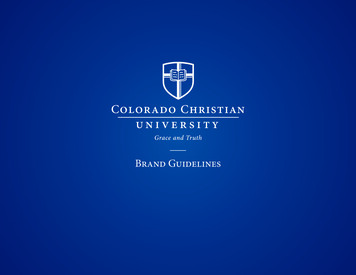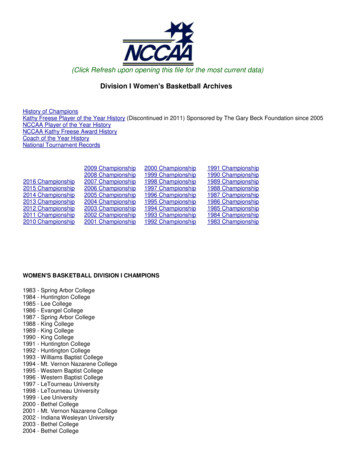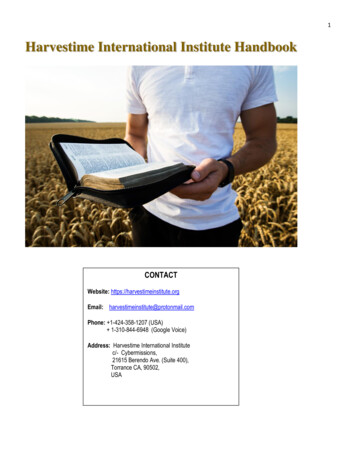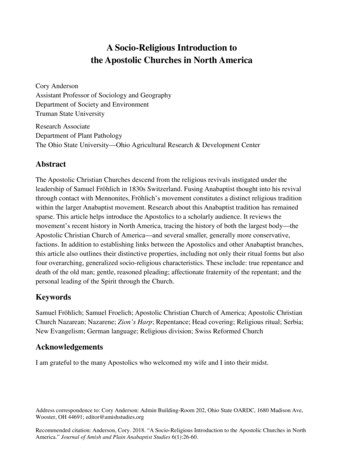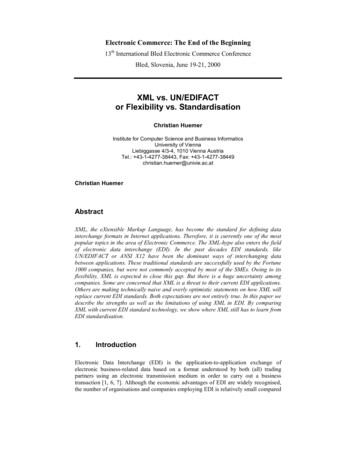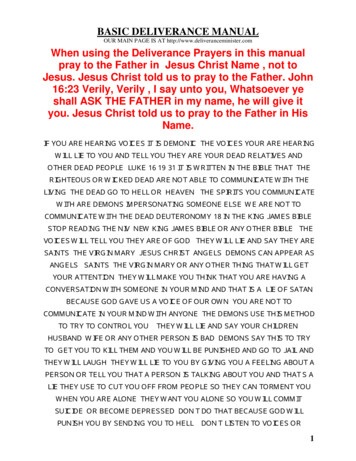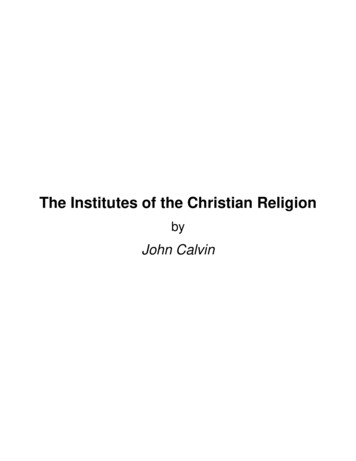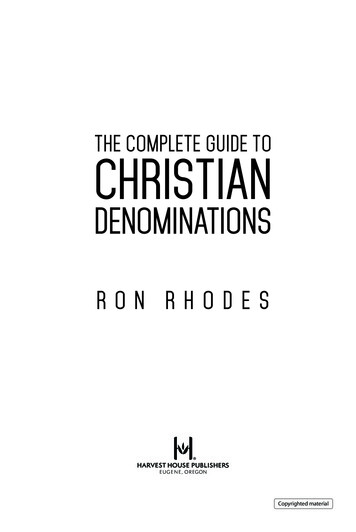
Transcription
Copyrighted materialComplete Guide to Christian Denominations.indd 111/18/14 9:12 AM
Unless otherwise indicated, all Scripture quotations are taken from the HOLY BIBLE, NEWINTERNATIONAL VERSION , NIV . Copyright 1973, 1978, 1984 by the InternationalBible Society. Used by permission of Zondervan. All rights reserved.Verses marked nkjv are taken from the New King James Version . Copyright 1982 by ThomasNelson, Inc. Used by permission. All rights reserved.Verses marked nasb are taken from the New American Standard Bible , 1960, 1962, 1963,1968, 1971, 1972, 1973, 1975, 1977, 1995 by The Lockman Foundation. Used by permission.(www.Lockman.org)All italicized emphasis in Scripture quotations is added by the author.Cover by Dugan Design Group, Minneapolis, MinnesotaCover illustration @ Michael Brown / FotoliaTHE COMPLETE GUIDE TO CHRISTIAN DENOMINATIONSCopyright 2005/2015 Ron RhodesPublished by Harvest House PublishersEugene, Oregon 97402www.harvesthousepublishers.comISBN 978-0-7369-5291-0 (pbk.)ISBN 978-0-7369-5292-7 (eBook)The Library of Congress has cataloged the edition as follows:Rhodes, Ron.The complete guide to Christian denominations / Ron Rhodes.p. cm.Includes bibliographical references and index.ISBN 0-7369-1289-4 (pbk.)1. Protestant churches—United States. 2. Protestant churches—Doctrines. I. Title.BR516.5.R47 2005280'.4—dc222004017507All rights reserved. No part of this publication may be reproduced, stored in a retrieval system, or transmitted in any form or by any means—electronic, mechanical, digital, photocopy,recording, or any other—except for brief quotations in printed reviews, without the prior permission of the publisher.Printed in the United States of America15 16 17 18 19 20 21 22 23 / VP-CD / 10 9 8 7 6 5 4 3 2 1Copyrighted materialComplete Guide to Christian Denominations.indd 211/18/14 9:12 AM
In honor of the head of the church (Ephesians 5:23),who purchased the church with His own blood (Acts 20:28)—Jesus ChristCopyrighted materialComplete Guide to Christian Denominations.indd 311/14/14 1:43 PM
AcknowledgmentsResearching every denomination in this book required considerable effort. Representatives of many of these denominationsmade the task easier by pointing me to helpful informationregarding their groups. To these individuals—too many tolist—I offer a heartfelt thanks.Kerri, David, and Kylie (my wife and adult children)—asalways, I could not have written this book without your continued support. God has used you mightily in my life!Copyrighted materialComplete Guide to Christian Denominations.indd 411/14/14 1:43 PM
CONTENTSBeginnings: The Emergence of Christianityand Denominations . . . . . . . . . . . . . . . . . . . . . . . . . . .1. Adventist Churches . . . . . . . . . . . . . . . . . . . . . . . . . . . .2. Baptist Churches . . . . . . . . . . . . . . . . . . . . . . . . . . . . . .3. Brethren Churches . . . . . . . . . . . . . . . . . . . . . . . . . . . .4. Catholic Churches . . . . . . . . . . . . . . . . . . . . . . . . . . . .5. Christian Churches . . . . . . . . . . . . . . . . . . . . . . . . . . . .6. Congregational Churches . . . . . . . . . . . . . . . . . . . . . . .7. Episcopal and Anglican Churches . . . . . . . . . . . . . . . . .8. Friends (Quaker) Churches . . . . . . . . . . . . . . . . . . . . . .9. Fundamentalist, Bible, and ConservativeEvangelical Churches . . . . . . . . . . . . . . . . . . . . . . . . . .10. Holiness Churches . . . . . . . . . . . . . . . . . . . . . . . . . . . .11. Lutheran Churches . . . . . . . . . . . . . . . . . . . . . . . . . . . .12. Mennonite Churches . . . . . . . . . . . . . . . . . . . . . . . . . .13. Methodist Churches . . . . . . . . . . . . . . . . . . . . . . . . . . .14. Orthodox Churches . . . . . . . . . . . . . . . . . . . . . . . . . . .15. Pentecostal Churches . . . . . . . . . . . . . . . . . . . . . . . . . .16. Presbyterian Churches . . . . . . . . . . . . . . . . . . . . . . . . .17. Reformed Churches . . . . . . . . . . . . . . . . . . . . . . . . . . .Postscript: Unity in Diversity . . . . . . . . . . . . . . . . . . . . .Appendix A: Website Addresses of AdditionalDenominations of Interest . . . . . . . . . . . . . . . . . . . . . . .Appendix B: Cults Are Not Denominations . . . . . . . . . .Notes . . . . . . . . . . . . . . . . . . . . . . . . . . . . . . . . . . . . . . .Bibliography . . . . . . . . . . . . . . . . . . . . . . . . . . . . . . . . .Index of Denominations . . . . . . . . . . . . . . . . . . . . . . . .Index of Persons . . . . . . . . . . . . . . . . . . . . . . . . . . . . . . .Chart Index . . . . . . . . . . . . . . . . . . . . . . . . . . . . . . . . . 407411417423425429435439Copyrighted materialComplete Guide to Christian Denominations.indd 511/14/14 1:43 PM
Copyrighted materialComplete Guide to Christian Denominations.indd 611/14/14 1:43 PM
BEGINNINGS: THE EMERGENCEOF CHRISTIANITY ANDDENOMINATIONSThe word Christian is used only three times in the New Testament, most importantly in Acts 11:26 (see also Acts 26:28and 1 Peter 4:16). In Acts 11:26, we are told simply and straightforwardly, “The disciples were called Christians first at Antioch.” Thiswould have happened around AD 42, about a decade after Christdied on the cross and rose from the dead.Until this time, the followers of Jesus referred to themselvesas brothers (Acts 15:1,23), disciples (Acts 9:26), believers (Acts5:12), and saints (Romans 8:27). Now, in Antioch, they were calledChristians.The term is loaded with significance. Among the ancients, theian (or ean) ending meant “belonging to the party of.” Herodiansbelonged to the party of Herod. Caesareans belonged to the partyof Caesar. Christians belonged to Christ. And Christians wereloyal to Christ, just as the Herodians were loyal to Herod and Caesareans were loyal to Caesar (see Mark 3:6; 12:13).The name Christian is noteworthy because these followers of7Copyrighted materialComplete Guide to Christian Denominations.indd 711/14/14 1:43 PM
8The Complete Guide to Christian DenominationsJesus were recognized as members of a separate group. They weredistinct from Judaism and from all other religions of the ancientworld. We might loosely translate the term Christian, “thosebelonging to Christ,” “Christ-ones,” or perhaps “Christ-people.”They are ones who follow the Christ.Those who have studied the culture of Antioch have noted thatthe Antiochians were well-known for making fun of people. Theymay have used the word Christian as a term of derision, an appellation of ridicule. Nevertheless, history reveals that by the secondcentury, Christians adopted the title as a badge of honor. Theytook pride (in a healthy way) in following Jesus. They had a genuine relationship with the living, resurrected Christ, and they wereutterly faithful to Him, even in the face of death.The city of Antioch was a mixture of Jews and Gentiles. Peopleof both backgrounds in this city became followers of Jesus. Whatbrought these believers unity was not their race, culture, or language. Rather, their unity was rooted in the personal relationshipeach of them had with Jesus. Christianity crosses all cultural andethnic boundaries.If a Christian is one who has a personal relationship with JesusChrist, then Christianity is a movement of people who have personal relationships with Jesus Christ. This may sound simplistic,but from a biblical perspective, this is the proper starting point.In the New Testament, the early Christians never referred totheir collective movement as Christianity, even though they usedthe term Christian with greater frequency as the movement grewin numbers. By the time of Augustine (AD 354–430), the termChristianity appears to have become a widespread appellation forthe Christian movement.The Birth of the ChurchScripture refers to both the universal church and the localCopyrighted materialComplete Guide to Christian Denominations.indd 811/14/14 1:43 PM
Beginnings: The Emergence of Christianity and Denominations9church. The universal church is a company of people who haveone Lord and who share together in one gift of salvation in theLord Jesus Christ (Titus 1:4; Jude 3). It may be defined as the everenlarging body of born-again believers who comprise the universal body of Christ, over which He reigns as Lord.Although the members of the church—and members of different denominations—may differ in age, sex, race, wealth, social status, and ability, true believers are all joined together as one people(Galatians 3:28). All of them share in one Spirit and worship oneLord (Ephesians 4:3-6). This body is comprised only of believersin Christ. The way one becomes a member of this universal bodyis to simply place faith in Christ. If you’re a believer, you’re in!The word church is translated from the Greek word ekklesia. This Greek word comes from two smaller words. The first isek, which means “out from among.” The second is klesia, whichmeans “to call.” Combining the two words, ekklesia means “to callout from among.” The church represents those whom God hascalled out from among the world and from all walks of life. All arewelcome in Christ’s church.Many theologians believe the church did not exist in Old Testament times (I think they are right). Matthew 16:18 cites Jesus assaying, “I will build my church” (future tense). This indicates thatwhen He spoke these words, the church did not yet exist. This isconsistent with the Old Testament, which includes no referenceto the church. In the New Testament, the church is portrayed asdistinct from Israel in such passages as Romans 9:6, 1 Corinthians10:32, and Hebrews 12:22-24. Therefore, we should not equate thechurch with believing Israelites in Old Testament times.Scripture indicates that the universal church was born on theDay of Pentecost (see Acts 2; compare with 1:5; 11:15; 1 Corinthians 12:13). We are told in Ephesians 1:19-20 that the church isbuilt on the foundation of Christ’s resurrection, meaning that theCopyrighted materialComplete Guide to Christian Denominations.indd 911/14/14 1:43 PM
10The Complete Guide to Christian Denominationschurch could not have existed in Old Testament times. The churchis thus called a “new man” in Ephesians 2:15.The one universal church is represented by many local churchesscattered throughout the world. For example, we read of a localchurch in Corinth (1 Corinthians 1:2), and another in Thessalonica (1 Thessalonians 1:1). Only a few local churches existedat first, but due to the missionary efforts of the early Christians,churches soon cropped up around the globe.Fast Facts onthe ChurchUniversal ChurchLocal Churchmembershipembraces all believers from Pentecostto the raptureembraces believers in a specificlocale who meetfor fellowship andworshipliving or deadincludes living anddead believersincludes livingbelievers onlydenominationalaffiliationincludes all truebelievers, regardlessof denominationalaffiliationnormally identified with a specificdenomination ormovementjoiningOne becomes amember by faith inChrist.One becomes amember by profession of faithin Christ plusany requirementsunique to thedenomination,such as baptism.Copyrighted materialComplete Guide to Christian Denominations.indd 1011/14/14 1:43 PM
Beginnings: The Emergence of Christianity and Denominations11The New Testament strongly urges believers to attend localchurches. Hebrews 10:25 specifically instructs us not to forsake meeting together. The Christian life as described in Scripture is to be lived in the context of the family of God and notin isolation (Acts 2; Ephesians 3:14-15). Moreover, by attendingchurch, we become equipped for the work of ministry (Ephesians4:12-16). The Bible knows nothing of a “lone ranger” Christian. Asthe old proverb says, many logs grouped together burn brightly,but embers that are isolated quickly die out (see Ephesians 2:19;1 Thessalonians 5:10-11; and 1 Peter 3:8).The Spread of ChristianityChristianity experienced phenomenal growth following thedeath and resurrection of Jesus Christ. We learn in Acts 1:15 thatabout 120 Jewish believers in Christ gathered in Jerusalem. A bitlater, after Peter’s powerful sermon, 3000 people became believers on the Day of Pentecost (Acts 2:41). The number soon grew to5000 (Acts 4:4). Soon enough, the Samaritans—whom the Jewsconsidered “unclean”—were added to the church (see Acts 8:5-25),as were the Gentiles (see Acts 10; 13–28).In Acts 1:8 the Lord instructed His disciples, “You will receivepower when the Holy Spirit comes on you; and you will be my witnesses in Jerusalem, and in all Judea and Samaria, and to the endsof the earth.” The rest of the book of Acts is a historical account ofhow Paul, Peter, and others empowered by the Holy Spirit spreadChristianity among both Jews and Gentiles around the northern Mediterranean, including Samaria (Acts 8:5-25), Phoenicia,Cyprus, Antioch (9:32–12:25), Phrygia and Galatia (13:1–15:35),Macedonia (15:36–21:16), and Rome (21:17–22:29). Despite persecution by Roman authorities, Jewish authorities, and others(2:13; 4:1-22; 5:17-42; 6:9–8:4), Christianity spread like wildfire.The apostle Paul went on three missionary tours (ActsCopyrighted materialComplete Guide to Christian Denominations.indd 1111/14/14 1:43 PM
12The Complete Guide to Christian Denominations13:1–14:28; 15:36–18:22; 18:23–21:17), spreading God’s Word instrategic cities like Antioch, Perga, Iconium, Lystra, Derbe, Troas,Philippi, Thessalonica, Berea, Athens, Corinth, Ephesus, Galatia,and Miletus. One of Paul’s strategies was to visit major Romancapitals that were easily reached by existing trade routes, a strategy that resulted in the gospel spreading out to other areas throughthese routes. Local churches popped up one after another.Fast-forward to the twenty-first century. Christianity has continued to grow and expand from the first century to the present,and it is now variously represented in some 300 denominationsin the United States alone. And this number is constantly in fluxas new denominations form and other denominations disappearfrom the religious landscape.With so many denominations sprinkled across the land, keeping track of their similarities and differences has become increasingly difficult. That is one reason I wrote this book. You will findthis book a handy guide that provides a brief history and doctrinalsummary of the mainstream denominations in the United States.Fast Facts onthe Necessity of Church Fellowship “There is nothing more unchristian than a solitary Christian”( John Wesley). “The New Testament does not envisage solitary religion; somekind of regular assembly for worship and instruction is everywhere taken for granted in the Epistles. So we must be regularpracticing members of the church” (C.S. Lewis). “Churchgoers are like coals in a fire. When they cling together,they keep the flame aglow; when they separate, they die out”(Billy Graham).Copyrighted materialComplete Guide to Christian Denominations.indd 1211/14/14 1:43 PM
Beginnings: The Emergence of Christianity and Denominations13What Is a Denomination?The English word denomination comes from the Latin worddenominare, which means “to name.” 1 In this book, you will findthat the names of denominations are diverse, reflecting a widerange of distinctive beliefs and practices.A denomination is “an association or fellowship of congregations within a religion that have the same beliefs or creed, engagein similar practices, and cooperate with each other to develop andmaintain shared enterprises.” 2 Seen in this light, Presbyterians arePresbyterians precisely because they share the same beliefs, engagein similar practices, and cooperate with each other to developand maintain shared enterprises. Likewise, Roman Catholics areRoman Catholics for the same reasons.Though the church experienced some sectarianism even in earlyNew Testament times (see 1 Corinthians 3:3-7), formal denominations are actually a relatively recent development. One reason forthis is that in many countries of the world, governmental authorities believed that civic harmony hinged on religious conformity.The recipe for a healthy society, they believed, included “one king,one faith, and one law.” 3 This is why so many countries have hadstate churches. They resisted the idea of allowing people to havefreedom of religious belief, for they thought such a policy wouldbe disruptive to society. When denominational groups did emergein some of these countries, persecution soon followed. Only withthe emergence of the United States did all this change in a significant way.The United States promises every American the free exercise ofreligion. This is one of the things that makes America so great. TheFirst Amendment, ratified in 1791, affirms that “Congress shallmake no law respecting an establishment of religion or prohibitingthe free exercise thereof.” 4 In keeping with this, James Madison,who became the fourth president of the United States (1809–1817),Copyrighted materialComplete Guide to Christian Denominations.indd 1311/14/14 1:43 PM
14The Complete Guide to Christian Denominationswrote, “The religion of every man must be left to the convictionand conscience of every man We maintain, therefore, that inmatters of religion no man’s right is [to be] abridged by the institution of civil society.” 5This policy is one reason so many people immigrated to the colonies in the early years of our country. As these people arrived, theybrought with them their churches and denominations.Among the English colonists there were Congregationalists in New England, Quakers in Pennsylvania, Anglicansin New York, Presbyterians in Virginia, and Roman Catholics in Maryland. In addition, there were Dutch, Swiss, andGerman Reformed [and] Swiss and German Lutherans. 6Transplanting their former churches onto American soil servedto help these immigrants adjust to their new surroundings. Theywere able to stay grounded in a familiar spiritual environment evenwhile getting used to their new physical environment. Eventuallythese various churches took on an American flavor and adapted tofit in with American society.With the passing of time, new denominations continued toemerge on American soil as a result of splits and mergers. Whydo denominations split? The answer is simple. Wherever humanbeings congregate, they will have differences of opinion aboutwhat to believe and how faith should be practiced. This bookwill illustrate how, in many cases, churches split off from a parent denomination because of differences in belief and/or practices,thereby giving rise to entirely new denominations.Copyrighted materialComplete Guide to Christian Denominations.indd 1411/14/14 1:43 PM
Beginnings: The Emergence of Christianity and Denominations15Fast Facts onChurch Attendance According to the New Testament, church attendance is notmerely optional—it is vital. Hebrews 10:25 specifically instructs, “Let us not give upmeeting together.” Scripture describes the Christian life as being lived in the context of the family of God and not in isolation (Acts 2; Ephesians 3:14-15). By attending church, believers become equipped for the workof ministry (Ephesians 4:12-16). The Bible knows nothing of “lone ranger” Christians (seeEphesians 2:19; 1 Thessalonians 5:10-11; and 1 Peter 3:8).What Are Protestants?The three major divisions of Christianity are the Roman Catholic Church, the Protestant Church, and the Orthodox Church. Iprovide a full history of how the Roman Catholic Church (chapter 4) and the Orthodox Church (chapter 14) emerged. However,the great majority of denominations in this book—includingthose affiliated with the Methodists, the Baptists, the Presbyterians, and the Lutherans—are Protestant. Therefore, an introductory history of Protestantism may be helpful.Protestantism refers to a broad system of the Christian faithand practices that emerged in the sixteenth century. It began as amovement seeking to bring reform to the Western (Roman Catholic) Church.The term Protestant was first coined in 1529 at the Diet ofSpeyer, an imperial assembly. Just three years earlier, another diet(or formal assembly) had granted tolerance to the Lutherans,Copyrighted materialComplete Guide to Christian Denominations.indd 1511/14/14 1:43 PM
16The Complete Guide to Christian Denominationsallowing them to determine their own religious position. Atthe Diet of Speyer, the Roman Catholic majority of delegatesrescinded this tolerance.Consequently, six Lutheran princes and the leaders of fourteen German cities signed a protest against this action, and itwas then that Lutherans became known as Protestants. Gradually, however, the term Protestant came to embrace all churchesthat were not affiliated with (and that had separated from) RomanCatholicism or Eastern Orthodoxy. This small beginning eventually mushroomed to embrace more than 400 million people (as ofAD 2000). About one-fifth of all Christians are Protestant.One religious researcher suggests, “If the Christian churchyou’re sitting in isn’t Orthodox or Roman Catholic, then you are ina Protestant church of one variety or another. The thing to remember about Protestants is that they protest.” 7 One cannot deny theelement of protest in the history of Protestantism. Many scholarsare quick to note, however, that the term protest etymologicallycarries the idea “to testify” or “to affirm.” Robert McAfee, in hisbook The Spirit of Protestantism, gives us this interesting insight:The verb “to protest” comes from the Latin protestari, andmeans not only “to testify” but, more importantly, “to testify on behalf of something.” Webster’s Dictionary givesas a synonym, “to affirm.” The Oxford English Dictionarydefines it, “to declare formally in public, testify, to make asolemn declaration.” The notion of a “protest against error”is only a subsidiary meaning. Thus, the actual word itselfis charged with positive rather than negative connotations.“To protest,” then, in the true meaning of the word, is tomake certain affirmations, to give testimony on behalf ofcertain things. 8The point, then, is that Protestantism is not simply a reactionary, negative movement. To be sure, the early Reformers did takeCopyrighted materialComplete Guide to Christian Denominations.indd 1611/14/14 1:43 PM
Beginnings: The Emergence of Christianity and Denominations17a stand against the teachings of the Roman Catholic Church. ButProtestants predominantly testify to what they consider to be thetruth!Distinctive Emphases of ProtestantismProtestants have strong convictions on quite a number of doctrines, but three are particularly important. These three serve todistinguish Protestantism from Roman Catholicism.1. The exclusivity of the Bible. Protestants view the Bible as theonly infallible rule of the Christian life and faith. It is consideredthe sole source for spiritual teachings. This is in obvious contrast toRoman Catholicism, which places heavy emphasis on the authority of tradition and the ex cathedra pronouncements of the pope.2. Salvation by grace alone through faith alone. Protestants havealways emphasized that the benefits of salvation are by grace alonethrough faith alone (Romans 4; Galatians 3:6-14; Ephesians 2:8-9).By contrast, Roman Catholics have historically placed a heavyemphasis on meritorious works in contributing to the process ofsalvation. This is not to say that Protestants view good works asunimportant. They simply believe good works are by-products ofsalvation (Matthew 7:15-23; 1 Timothy 5:10,25).3. The priesthood of all believers. In Roman Catholicism, thepriest is the intermediary between the believer and God. For example, a person must confess sins to a priest, who then absolves thatperson of sin. By contrast, Protestants believe each Christian is apriest before God and thus has direct access to Him without needfor an intermediary (see 1 Peter 2:4-10).Divisions Within ProtestantismThe independent spirit intrinsic to Protestantism has been botha strength and a weakness. It has been a strength in that it has hada revitalizing effect on church members who are free to directlyCopyrighted materialComplete Guide to Christian Denominations.indd 1711/14/14 1:43 PM
18The Complete Guide to Christian Denominationsinteract with God and serve Him freely in the church. It has been aweakness in that such independence has led to numerous denominational splits throughout history.Today, Protestantism includes many denominations—eachhaving some distinctive beliefs and histories. Lutheran churches,for example, emerged out of the reforming work of Martin Lutherin the early sixteenth century in Germany. Churches in both thePresbyterian and Reformed traditions emerged largely from theCalvinistic side of the Reformation. The Methodist church grewout of the holiness teachings of John Wesley. The work of severalinfluential Christian leaders gave rise to new denominations.Fast Facts onInfluential Religious LeadersHistorical PersonDenominationPope Leo I (400–461)Early pope of the RomanCatholic Church, during whose reign claims ofpapal authority over all otherchurches were first made.Michael Cerularius (d. 1058)Patriarch of Constantinoplein power when the EasternOrthodox Church split offfrom Roman Catholicism.Martin Luther (1483–1546)German Reformer. Followersbecame the Lutherans.Menno Simons (1496–1561)Dutch leader. Followersbecame the Mennonites.Copyrighted materialComplete Guide to Christian Denominations.indd 1811/14/14 1:43 PM
Beginnings: The Emergence of Christianity and DenominationsKing Henry VIII (1509–1547)King responsible for theChurch of England’s breakwith the Roman CatholicChurch. (Anglican and Episcopal churches emerged out ofthe Church of England.)John Calvin (1509–1564)French Reformer. Led to riseof Presbyterian churches andReformed churches.George Fox (1625–1691)Mystical preacher. Led to riseof Friends (Quaker) churches.Jakob Amman (1656–1730)Swiss Mennonite bishop. Ledto rise of Amish churches.John Wesley (1703–1791)Evangelist and missionary. Ledto rise of Methodist churches.Thomas Campbell(1763–1854)Alexander Campbell(1788–1866)Barton Stone (1772–1844)Three individuals instrumentalin founding Christian or Disciples of Christ churches.William Miller (1782–1849)Itinerant preacher. Led to riseof Adventist churches.Phoebe Palmer (1807–1874)Itinerant speaker. Led to rise ofHoliness churches.Dwight L. Moody(1837–1899)John Nelson Darby(1800–1882)Cyrus Scofield (1843–1921)Three individuals instrumental in the rise of fundamentalistBible churches.19Copyrighted materialComplete Guide to Christian Denominations.indd 1911/14/14 1:43 PM
20The Complete Guide to Christian DenominationsWilliam J. Seymour(1870–1922)Evangelist whose Azusa StreetRevival in Los Angeles led toPentecostal churches.How to Use This BookThis book is divided into 17 alphabetized groupings ofdenominations—Adventist churches; Baptist churches; Brethrenchurches; Catholic churches; Christian churches; Congregationalchurches; Episcopal and Anglican churches; Friends (Quaker)churches; fundamentalist, Bible, and conservative Evangelicalchurches; Holiness churches; Lutheran churches; Mennonitechurches; Methodist churches; Orthodox churches; Pentecostalchurches; Presbyterian churches; and Reformed churches. In eachcase, I provide a brief history of the emergence of the group as awhole before dealing with specific denominations in that group.For example, I provide a brief Baptist history before providinginformation on relevant Baptist denominations.This book is not intended as an apologetic critique of eachdenomination. Rather, it is intended to provide a brief history anddoctrinal summary of the major denominations in North America.I do not personally endorse the teachings of some of the denominations in this book.Unlike some other denomination handbooks, this book doesnot provide information about denominations from Judaism,world religions like Islam, or cultic groups. For example, you willnot find listed in this volume information on the Mormons orthe Jehovah’s Witnesses. These groups may claim to be Christianbut in fact are not Christian because they deny one or more of theessential doctrines of Christianity as taught in the 66 books of theBible. 9 (See appendix B, “Cults Are Not Denominations.”)For each denomination I provide statistics on churchCopyrighted materialComplete Guide to Christian Denominations.indd 2011/14/14 1:43 PM
Beginnings: The Emergence of Christianity and Denominations21membership and the number of congregations in the denomination. Please note, however, that these statistics should not be takenas “gospel truth.” Some churches, in their membership rolls, countall baptized persons, including infants. Others exclude infants andinclude only adults who have made a formal profession of faith inChrist. Some churches include only members in good standing.Others include people who officially joined the church at somepoint but rarely ever attend services. Some churches are not carefulabout excluding the deceased or those who have left their congregations. In a number of cases, one person may be on the membership rolls of more than one church. 10 Such factors make obtainingexact figures extremely difficult, if not impossible. Nevertheless,the figures presented in this book are good guesstimates.Though I seek to provide helpful doctrinal summaries of thevarious denominations I cover in this book, some of them publishless information than others regarding their beliefs. For this reason, some denominations in this book have briefer doctrinal summaries than others.Moreover, I have chosen to allow each denomination to speakfor itself as to its doctrinal position. I based my doctrinal summaries on the doctrinal statements of the various denominations.There is both an upside and a downside to this. The upside is fairdoctrinal representation. The downside is that in many cases
The Spread of Christianity Christianity experienced phenomenal growth following the death and resurrection of Jesus Christ. We learn in Acts 1:15 that about 120 Jewish believers in Christ gathered in Jerusalem. A bit later, after Peter’s powerful sermon, 3000 people became believ-ers on
